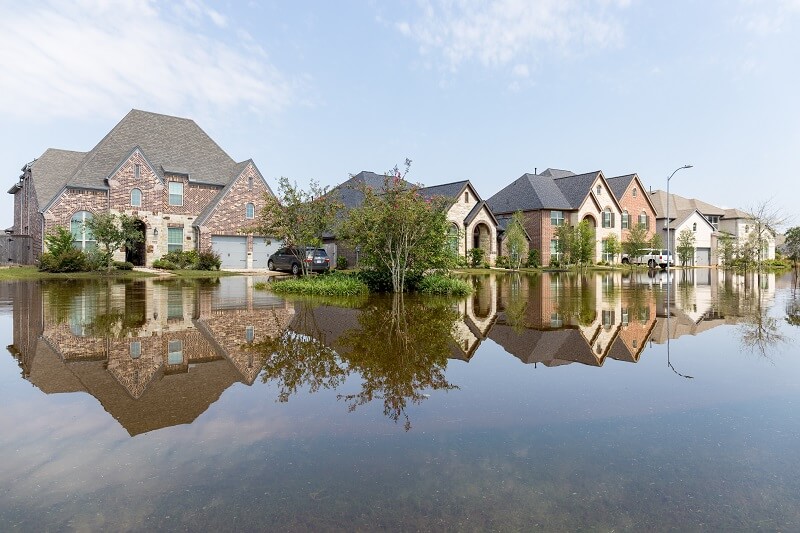
House floods are an extremely severe situation, and unfortunately, they’re becoming more common.
Whether the flood came from a natural disaster, flash flood, heavy rains, or a burst pipe, it can cause substantial damage and safety hazards. Knowing what to do after a flood is hard, but we’re here to help. Home floods can be destructive and dangerous, so approach the situation cautiously.
Keep reading to learn how to safely and effectively deal with the aftermath of a flood.
House Is Flooded? Here’s What to Do
A flood in your home is stressful and scary. When your home is full of water, it can be hard to know what to do next, but this section will detail what to do while the flood is still happening and what you can do after the flood to begin repairs and clean up.
First, let’s discuss what to do when your house is flooding. When water is actively coming into your home, the first thing to do is turn off your electrical system. When water gets into places it shouldn’t it can be a life-threatening electrical hazard, so eliminate that problem as soon as possible.
Next, turn off your water if your plumbing is the source of the flood. If a pipe bursts, a toilet backs up, or a tub overflows, find your water valve and turn it off to prevent further damage.
Once you turn off the water supply and electricity, you can begin documenting and remedying the flood. Put on protective equipment or waterproof clothing and remove any valuables.
Irreplaceable family heirlooms, sentimental items, expensive things, and crucial documents should be the first items you remove. Take them to a safe, dry place.
Once you save important items, you can move wet objects outside and remove water. Take pictures and videos of the flood and damage for your insurance company.
If the flood was not caused by nature, like a rainstorm, open windows to increase airflow. Standing water is hazardous and harmful, so if it’s safe to be inside your home, it’s beneficial to start moving water as soon as possible.
Serious floods typically require professional help to remove and fix, but the steps above are things you can do to be proactive before you call for help. Contact your insurance company about homeowners insurance policies once you’ve done as much as you can.
Calling Out a Repair Company
Drastic floods can wreak havoc on your home. A flood can destroy things like electronics and furniture. In the worst-case scenarios, floods can ruin your floors and compromise your home’s foundation.
Fully grasping the extent of flood damage to your home can be difficult, so best to call a repair company so a professional can assess the damage. Most homeowners call their insurance company first and may hire an in-network repair company. But you can also hire a repair company before filing a home insurance claim, so you have a better idea of the situation.
Water damage restoration and water removal professionals should be the first call. However, you will likely also need to call an electrician and plumber. Talking to professionals will help you understand the costs of fixing a house following a flood.
Floods can leave behind unseen problems, such as mold growth, contaminants, and poor air quality, so have your home professionally inspected for damage and dangers by a contractor or adjuster.
Repairing Flood Damage
Hiring a water restoration company to remove water and remove damaged parts of your home can be extremely expensive. You will likely have to hire an electrician or plumber, but you can skip the water restoration costs if you handle the water removal, dry out, and clean-up processes yourself! Follow the steps below to repair flood damage in your home:
- First, determine the type of water in your home. There are three types of flood water: clean, gray, and black.
Clean water is safe to clean up; it’s usually from rain, condensation, or leaky pipes. Gray water is also safe to clean up. It’s slightly dirty and comes from dishwashers, washing machines, and clean toilets. Lastly, black water comes from sewage or flooding from nearby rivers and is unsafe to clean up unless you’re a professional.
- Once you’ve determined the water is not black, remove all the standing water. You can use a large bucket, a sump pump, or a water vac. None of these methods are easy and take considerable time and effort. If the flood was severe, it can take days to remove all the standing water.
- Next, inspect for mold and mildew. Mold can start to grow within 24 hours. Look for black, green, pink, and orange residue on wet surfaces. If it’s black, call for a professional cleaning service. Otherwise, you can disinfect or use a bleach solution on the areas.
- Using a massive fan, dry out the affected areas in your home. Try not to leave any moisture behind, as it can lead to mold and mildew. These fans can also help improve your indoor air quality, which is often compromised during a flood.
- Remove any porous or damaged parts of your home, including flooring, carpet, drywall, wallpaper, and ceilings. Inspect your external siding and gutters for damage as well.
- Once you’ve removed all standing water, moisture, signs of mold, and water-damaged items and materials, disinfect your entire home. If you’re struggling to remove the moisture you may need to dehumidify your home at this point in the process. Thoroughly clean everything with disinfectant and dehumidify your home.
After your home has been disinfected, you can begin repairing materials you had to throw away. Begin by replacing the ceiling and floors, followed by drywall, and then repair any external damage to your home. If your home suffered substantial flood damage and you’re not handy, you may need to hire a contractor.
Dehumidifying your home is a major part of repairing flood damage. It can be a long process and complex process, which the section below will explain.
Dehumidifying Your House
Standing water and water damage are not the only problems a flood can leave behind. Floods can compromise the air in your home, so dehumidifying is important. You’ll need to invest in powerful dehumidifiers if you don’t already own any. Small dehumidifiers will likely not be effective if there is substantial moisture. You can invest in heavy-duty humidifiers or rent them from places like Home Depot.
Dehumidifiers suck the water out of the air and porous surfaces. After a severe flood, you may need to run a dehumidifier or multiple dehumidifiers for several weeks. For minor floods, a heavy-duty dehumidifier should be able to dry out the area in a few days.
Open cabinets, closets, and doors to speed up the dehumidification process and thoroughly dry out those small spaces. You can also dry your home faster by strategically placing the dehumidifiers. Placing them closer to the wet areas, spacing them out in your home, and putting them in a crawl space can dry out your house quicker.
Unfortunately, this process can take a while and it’s hard to predict how long you need to run the dehumidifier to dry out the walls.
Need to Sell Your House Fast?
We make selling your house a simple affair – even if it’s flooded.
Just fill out the form below or give us a call at: (612) 260-5577 to get your free, no-obligation cash offer!
Can You Sell a House with Flood Damage?
If your house suffered massive flood damage that you’re not willing to repair, you can still sell it! Many companies that buy houses in any condition will happily take your flooded home off your hands. You can get more money from cash home buyers in Minnesota if you repair some or most of the flood damage, but it is still possible to sell a house with substantial damage.
We know that handling the aftermath of a flood can be overwhelming and traumatic. But we buy houses Minneapolis residents want to sell fast, so you can put the flood behind you and move on to somewhere new.
Do You Need to Document Flood Damage?
Yes, you should always thoroughly document flood damage. Whether you’re a renter or homeowner, documentation can help with insurance claims and liability. Take as many pictures and videos as you can so you can give your landlord or insurance company a comprehensive understanding of the flood damage.
Do not risk your safety to take pictures or videos, but try to get as much as you can. Take pictures at every point, including during the clean-up process. Sometimes, standing water can hide severe damage, so you need pictures of the water as well as the damage underneath.
Take pictures of damaged items even after you’ve removed them from your home, and don’t forget to photograph external damage like your home’s siding or foundation. You can also document the flood damage in other ways, such as a written inspection report from a professional.

Conclusion
Dealing with the aftermath of a flood is a lot of work. It’s also emotionally and mentally taxing to have your home flooded.
Every aspect of handling a flood in your home is a nightmare, from insurance claims to standing water to mold spores to structural damage. It’s possible to repair all the damage, but it is hard.
If the flood is too much for you and you want to sell a house fast in Plymouth or elsewhere and leave this mess behind, contact Mill City Home Buyers for a quote today!
